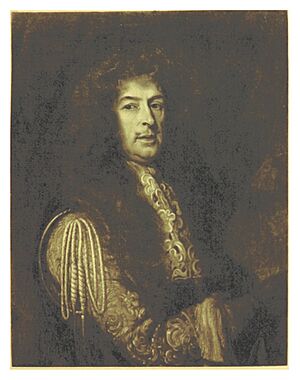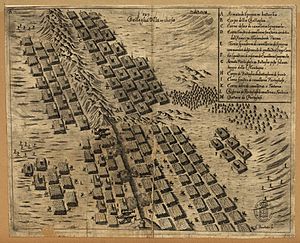English expedition to Portugal (1662–1668) facts for kids
The English expedition to Portugal was a group of English soldiers who went to Portugal in 1662. They were also known as the British Brigade in Portugal. These soldiers were sent by King Charles II to help Portugal fight against Spain in the Portuguese Restoration War. Many of these soldiers were experienced fighters from the English Civil Wars. The brigade was led by Frederick Schomberg, 1st Duke of Schomberg and played a very important part in helping Portugal win its independence. The soldiers stayed in Portugal until the war ended in 1668.

Contents
Why England Sent Help
The war between Portugal and Spain started in 1640. Portugal wanted to be free from Spain, but Spain was still a strong country. Portugal needed help from other countries.
They asked their old friend, England, for support. At first, there was a question mark because King Charles II of England had been friends with Spain before. But Charles II decided to help Portugal instead. He married Catherine of Braganza, a Portuguese princess. This marriage made the alliance between England and Portugal even stronger.
Sending soldiers to Portugal also helped King Charles II. Many soldiers from the English Civil War (both those who fought for the King and those who fought against him) needed jobs. The Portuguese army also needed experienced fighters to help them against Spain.
Forming the Brigade
The English soldiers were gathered from different parts of England and Scotland. Some were from regiments that had not yet been sent home. The cavalry (soldiers on horseback) were volunteers, many of whom had fought against Spain before.
The English Parliament helped to get the brigade ready and paid them at first. Once the soldiers were in Portugal, the Portuguese government paid them. Most of the soldiers were Protestants, but there were also many Catholic soldiers from Ireland and Scotland.
The brigade was trained and led by Thomas Morgan, a skilled soldier from Wales. The brigade had about 3,000 men in total. This included two groups of infantry (foot soldiers), each with 1,000 men, and one group of cavalry, with nearly 1,000 men.
Fighting in Portugal
When the British soldiers arrived in Portugal, they quickly joined the fight. At first, some Portuguese officers didn't trust them, partly because the British were Protestant. But soon, the Portuguese realized that the British soldiers were very reliable and made a big difference against the Spanish.
However, the brigade faced challenges. Many soldiers got sick, and it was hard to replace those who were lost in battle or to illness.
Soldiers and Leaders
The British army uniform was red. Red jackets had been a common color for English soldiers since the time of Queen Elizabeth I. By the 1660s, red became the main color for British uniforms.
The first commander of the British Brigade was Murrough O'Brien, 1st Earl of Inchiquin. In 1662, he was replaced by Frederick Schomberg, 1st Duke of Schomberg. Schomberg was sent to Portugal as a military advisor. He became a very important leader for the brigade.
Key Battles
In the spring of 1663, a Spanish army led by Don Juan de Austria captured the city of Évora in southern Portugal. This opened the way for them to march on Lisbon, the capital city.
The British brigade joined the Portuguese army. Their first fight was near Degebe in June, where they stopped the Spanish from crossing a river.
Battle of Ameixial
Soon after, the armies met near Évora. At the Battle of Ameixial, the Anglo-Portuguese forces quickly defeated the Spanish. The Spanish lost many soldiers and all their cannons and supplies. They had to retreat. The Spanish soldiers in Évora then gave up without a fight. The British brigade did not lose any men in this part of the battle.
Siege of Valencia de Alcántara
After more disagreements about getting supplies, Schomberg and the British brigade continued fighting. On June 10, 1664, they began the Siege of Valencia de Alcántara. Two weeks later, the English soldiers led the main attack. They suffered many losses but forced the Spanish soldiers to surrender.
The Portuguese leaders were very impressed. The Count of Castelo Melhor said:
the English had done more than can be expected of them and I believe there a no soldiers in the world like them.
– Count of Castelo Melhor.
Battle of Montes Claros
On June 17, 1665, the brigade was crucial at the Battle of Montes Claros. The Portuguese commander, António Luís de Meneses, 1st Marquis of Marialva, placed the British brigade in the most important and dangerous part of the battle line. Schomberg's horse was shot from under him, and he almost got captured. But the experienced brigade fought bravely and helped win a decisive victory against the Spanish.
After Montes Claros, Spain could not gain any major advantages. The war continued, but Portugal was safe from big attacks. Over the next two years, Schomberg and the English brigade led several raids across the border, capturing fortresses and towns.
In September 1667, a ceasefire was declared after a political change in the Portuguese court.
The War Ends
England and Spain signed a treaty in Madrid in 1667. In this treaty, England agreed to help Portugal and Spain make peace.
In 1668, Spain finally accepted that Portugal was an independent country. They signed the Treaty of Lisbon, with England's help. This officially ended the war.
After the war, the British brigade was broken up. About 1,000 men remained from the original 3,500. Some of these soldiers joined the English garrison in Tangier (a city in North Africa that England controlled). The rest were sent back to England. Some soldiers stayed in Portugal, where they had found wives or new jobs.


